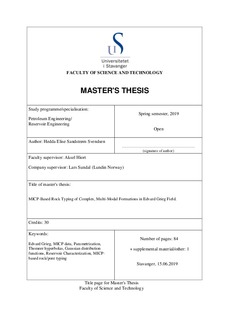| dc.description.abstract | Rock/pore typing is a process of classifying reservoir rocks into units with similar petrophysical properties. When properly classified, each unit possesses a unique porosity-permeability relationship. This leads to improved reservoir characterization, which further leads to improved decision-making and finally, improved oil recovery.
This thesis investigates whether parametrization of mercury injection capillary pressure (MICP) curves could be used for rock/pore typing of the complex, multi-modal formations in Edvard Grieg field. The heterogeneous origin of the field together with different diagenetic processes lead to large variation in the porosity-permeability distribution, even within facies. Therefore, conventional rock typing methods tend to fail. This leaves room for improved reservoir characterization by using MICP-based rock/pore typing.
In this study, the parametrization of the MICP data was performed by using Thomeer hyperbolas and modified Gaussian error distribution functions, assisted by a workflow based on a spreadsheet developed by Lundin Norway. Quality control (QC) of MICP data is incorporated in this workflow to ensure that only high-quality MICP data is included in the rock/pore typing procedure. The workflow’s main focus is on Thomeer curve fitting procedure.
A total of 273 MICP samples from the Edvard Grieg field were analyzed, including QC. The lithology of the samples varied from good sorted aeolian sandstones to poorly sorted alluvial fan conglomerates. The analysis has shown that parametrization of MICP data using Thomeer hyperbolas provides good results for aeolian sandstone samples, it does not, however, provide good results for alluvial fan conglomerate samples. Further investigations identified a critical weakness related to the Thomeer curve fitting procedure: it is sensitive to heterogeneous pore-throat distributions, resulting in unrealistic Thomeer parameters. These findings indicate that the Thomeer curve fitting procedure is not suitable for evaluation of alluvial fan conglomerates in Edvard Grieg field, since these formations are often associated with heterogeneous pore-throat distributions. This study has suggested that Gaussian error distributions are a better alternative than Thomeer hyperbolas for alluvial fan conglomerates, but future investigations are needed.
Moreover, investigations of the Thomeer parameters were performed and the analysis showed: high correlation between the Thomeer parameter equivalent to largest pore-throat radius and permeability measured by CCA. This was used for rock/pore typing attempts, the study suggests that the Thomeer parameter equivalent to largest pore-throat radius, could be used as cut-off parameter for rock/pore typing of the complex, multi-modal formations in Edvard Grieg field, but future studies are needed to confirm. | nb_NO |

